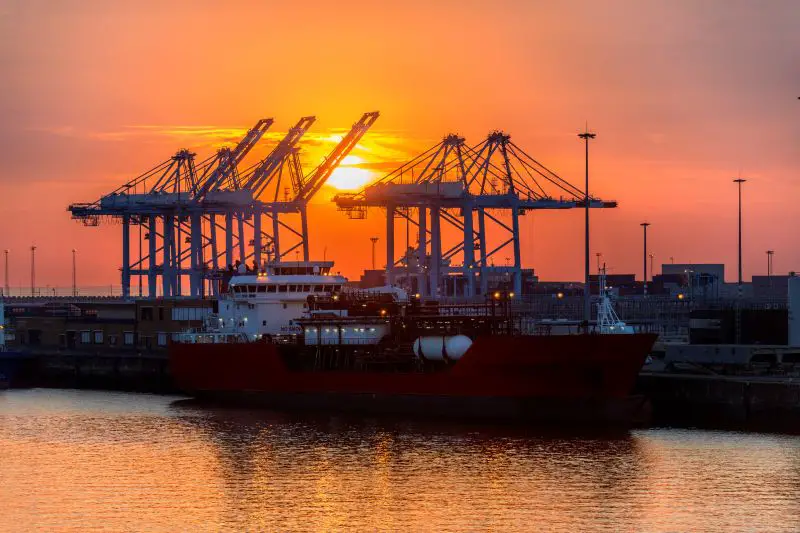Click here to get this post in PDF
This article contains affiliate links. For more info, see disclosure.
Shipping and logistics are the lifeblood of international commerce, ensuring the seamless movement of goods worldwide. Approximately 85% of world trade is transported by sea, highlighting the maritime industry’s pivotal role in connecting markets and facilitating economic growth. This intricate network not only supports the availability of consumer goods, energy, and raw materials but also underpins the very fabric of modern society.
The Backbone of Global Trade
The maritime sector’s significance in global trade cannot be overstated. Most of the world’s trade is transported across the oceans; maritime shipping is not merely a cornerstone of economic activity but a vital engine driving global growth and connecting markets worldwide. This dominance is attributed to sea transport’s efficiency and cost-effectiveness, especially for bulk commodities and large-scale shipments. The vast network of shipping routes and ports enables businesses to source materials and distribute products internationally, fostering economic interdependence among nations.
Economic Impact
The shipping industry is a cornerstone of the global economy. In 2020, it was valued at over $14 trillion; projections estimate it could reach $15.9 trillion by 2027. This growth is driven by increasing demand for goods and expanding global supply chains. The industry’s economic influence extends beyond transportation; it encompasses shipbuilding, port operations, and various ancillary services, collectively generating employment for millions worldwide.
Environmental Considerations
While driving global trade and economic growth, the shipping industry is also taking significant strides toward environmental sustainability. With growing awareness of its environmental impact, the sector proactively adopts innovative solutions to reduce emissions and promote cleaner practices. Advances in low-emission fuels, such as LNG, green ammonia, and hydrogen, and the development of energy-efficient vessel designs and propulsion technologies, are transforming maritime transport. Industry-wide initiatives and forward-thinking regulations encourage greener operations, positioning the maritime sector as a key player in transitioning to a more sustainable and environmentally responsible global economy.
The Energy Transition in Shipping
The shipping industry is undergoing a significant energy transition in response to environmental concerns. This shift involves moving away from fossil fuel-based energy sources and towards alternative renewable fuels like wind and solar power. Offshore renewable energy is rapidly expanding and will supply 9% of global energy needs by 2050. To reduce the industry’s carbon footprint, this transition necessitates substantial investment in new technologies, infrastructure, and the development of commercially viable alternative fuels.
Technological Innovations
The maritime sector embraces technological innovations to meet environmental targets and improve efficiency. Modern sail-powered cargo ships are being reintroduced to reduce reliance on fossil fuels. For instance, vessels like the Grain de Sail II use advanced sail technology to harness wind energy, significantly reducing diesel consumption. While wind power cannot be activated like traditional engines, hybrid models aim to achieve up to 70% propulsion from wind energy, marking a substantial step towards sustainable shipping practices.
Regulatory Measures and Global Policies
Governments and international organisations are implementing policies to address shipping’s environmental impact. The International Maritime Organization (IMO) has set ambitious targets to reduce greenhouse gas emissions from shipping by at least 50% by 2050 compared to 2008. To achieve this, regulations such as the 2020 sulfur cap have been introduced, limiting the sulfur content in marine fuels to 0.5%, down from the previous 3.5%. These measures compel the industry to adopt cleaner fuels and technologies, driving the energy transition forward.
Challenges and Opportunities
The path to a greener maritime industry is fraught with challenges, including high costs of new technologies, infrastructure development, and the availability of alternative fuels. However, these challenges also present opportunities for innovation and leadership in sustainable practices. Companies investing in research and developing eco-friendly technologies stand to gain a competitive edge as global trade increasingly prioritises sustainability.
Shipping and logistics are indispensable to international commerce, enabling the flow of goods and fostering global economic integration. The ongoing energy transition offers sustainable growth pathways as the industry confronts environmental challenges. Through technological innovation, regulatory compliance, and a commitment to environmental stewardship, the maritime sector can continue to drive international commerce while minimising its ecological footprint.
Also read:
Image source: elements.envato.com

